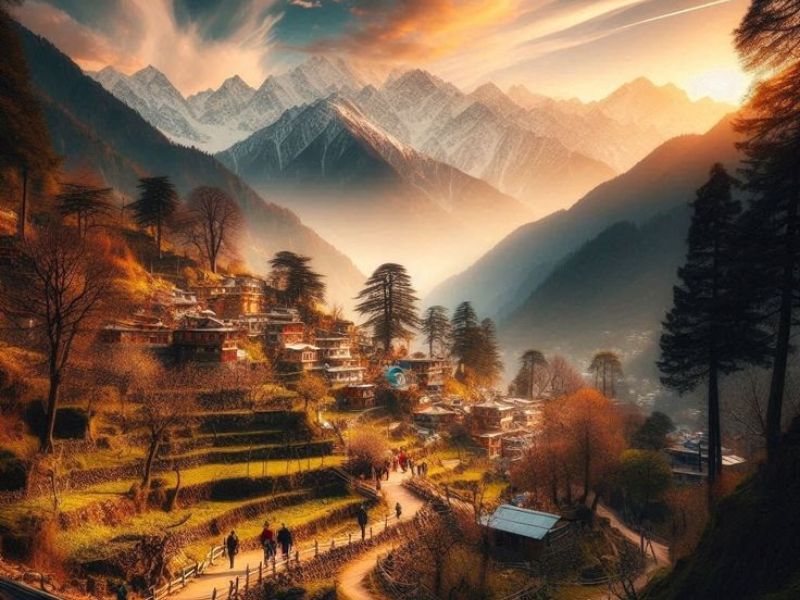Himachal Village Life: The Heartbeat of the Hills
Life in the villages of Himachal Pradesh is different from the fast-paced urban environments that many people are accustomed to. The people here live by the rhythms of nature. Agriculture is the main source of livelihood for many, with terraced fields of wheat, barley, and maize stretching out across the mountains.
Himachal Pradesh is often celebrated for its stunning landscapes and majestic mountains. However, the real essence of this state lies in its villages, where life moves at a much different pace. Nestled in the hills, these villages embody a way of living that is deeply connected to nature and steeped in tradition. While cities race ahead with modernity, village life in Himachal remains a testament to simplicity and community.
A Simpler Way of Life
In the villages of Himachal, the day starts early. As the sun rises, families begin their routines, often tending to their farms and animals. Most households rely on agriculture, growing staples like maize, barley, and wheat on terraced fields. The houses, built from local stone and wood, are functional yet charming, featuring slate roofs and intricately carved wooden doors that tell stories of craftsmanship passed down through generations.
Life here is refreshingly simple. In the evenings, villagers gather outside their homes, sharing stories over cups of tea made from fresh milk. The laughter of children fills the air as they play in open fields, away from the distractions of technology. There’s a sense of calm here, where time doesn’t seem to matter as much.
The Heart of Community
In Himachal’s villages, community is everything. Neighbors support one another, creating a network of relationships that fosters a sense of belonging. Whether it’s helping with the harvest or coming together for a wedding, the bonds in these communities run deep. Festivals like Lohri and Baisakhi bring everyone together, with colorful celebrations that showcase traditional music and dance.
Traditions are not just relics of the past; they are woven into the fabric of daily life. Villagers celebrate festivals with joy, and rituals are performed with care, honoring their ancestors and the land. There’s a beauty in this continuity—a sense of identity that defines their existence.

Living in Harmony with Nature
What sets Himachali village life apart is the profound respect for nature. The majestic Himalayas are not just a backdrop; they are part of daily life. Villagers understand that their livelihoods depend on the land and the environment surrounding them. Each household typically has its small plot of land where they grow their own food, practicing sustainable farming methods that have stood the test of time.
Water is sacred in these villages. Many families have access to freshwater springs, which are often treated with reverence. It’s common to see villagers offering prayers at these sources, acknowledging their importance in sustaining life.
The Challenges of Rural Life
While life in the villages is beautiful, it’s not without challenges. The isolation of these mountainous areas can be tough, especially during winter when heavy snowfall can cut off access. Villagers often prepare for these months, stockpiling food and supplies to last until the roads clear.
Healthcare and education can also be limited, requiring villagers to travel long distances for basic services. Despite these hurdles, the resilience of the Himachali people shines through. They have adapted to their environment, relying on each other and their traditions to navigate life’s difficulties.
Discovering Malana
One of the most intriguing villages in Himachal is Malana, located in the Parvati Valley. Known for its unique culture and self-governance, Malana village attracts visitors curious about its traditions. The locals believe they are descendants of Alexander the Great, adding an air of mystique to the village.
While tourism brings new energy, it also comes with rules. Interaction with villagers is limited to preserve their way of life. Exploring Malana offers visitors a glimpse into a world where ancient customs remain strong, making it a unique destination for those who seek authenticity.
The Richness of Himachali Culture
Every village in Himachal has its own character, but they all share a common thread of rich cultural heritage. The region is known for its craftsmanship—handwoven shawls made from local wool and intricate wood carvings are just a couple of examples. These crafts aren’t just for sale; they reflect the creativity and skills that have been honed over generations.
Traditional music and dance are integral to village life. During festivals, people gather to perform the Nati, a lively folk dance that encourages participation from everyone.
Balancing Tradition and Modernity
While the charm of village life persists, change is inevitable. Improved roads and connectivity have opened these villages to tourism, which can be a double-edged sword. On one hand, it provides economic opportunities; on the other, there are concerns about preserving the local culture and environment.
Villagers are aware of this balancing act. Many are taking steps to promote eco-tourism, inviting visitors to appreciate the beauty of their home while ensuring that their traditions remain intact. There’s a hope that the future will bring both prosperity and the preservation of their unique way of life.
Conclusion
It embodies simplicity, community, and a deep connection to nature. The warmth of the people, the beauty of their traditions, and the stunning landscape make these villages the heartbeat of the hills. Visiting Himachal’s villages is more than just a trip; it’s an experience that reconnects us with the values of community and the importance of living in harmony with the world around us.
Read Blog Post - Taste Kerala: Culinary Journeys with India Highlight
